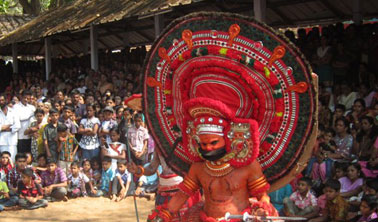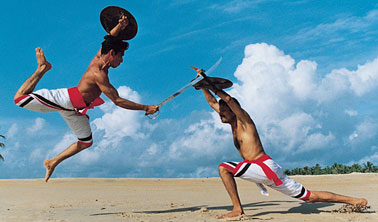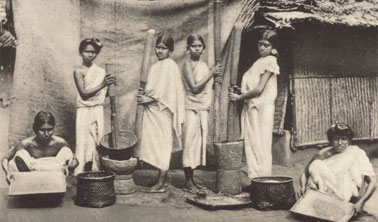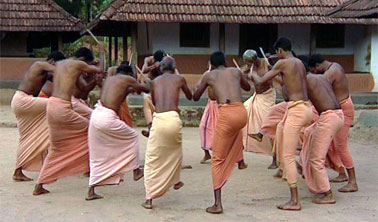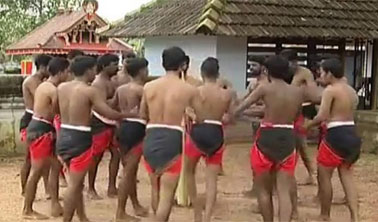Theyyam
The gift of the village in the field of art and culture is 'theyyam'.
This is a highly ritualistic dance, well preserved with its rare and sometimes grotesque make-up and costume, lively foot work and gymnastic fervor. It represents a glorious period of folk-life in Dharmadam as well as in Kerala.
The Gods and Goddesses are supposed to come in our midst through the medium of the possessed dancers and converse with us on matters of even contemporary significance. It is sometimes found that Theyyams pronounce judgements on temporal matters and give blessings to the believers.
The Theyyam dance is performed during the festivals of the shrines known by names like muchilode, kavu, palliyera mundya, tanam, madhappura etc. It has grown through centuries to its present form.
Theyyam is essentially a human creation; it has an absolute relationship with man in giving vent to his strong feelings against injustice and wickedness and his desire to maintain the well-being of society.
The head gear or the mask, made of locally available materials from nature and painted with natural colours, assumes a grotesque and archetypal image with the blending of highly artistic and emotive displays.
The folk singer, while he sings out in a loud voice, accompanying Theyyam or along with his own dancing steps, uses simple, but effective language and straight, but thought-provoking, images. The rudiments of the dance music which later developed and evolved into the art of "Krishnanattam" and "Kathakali" can clearly be found in Theyyam music. Theyyam songs belong to a literary tradition of the farthest past which had not evolved through any conscious process of sophistication, but serves as a life-giving vehicle of the feelings of village communities.
Kalaripayattu
Kalari means school and Payattu means combat, Kalaripayattu is one of the advanced combat sciences of the world and has produced many a hero whose exploits are celebrated in legends and folk songs.
In the past, each desom or locality had its kalari or gymnasium, presided over by the guardian deity called Kalari Paradevatha or Bhagavathi. Most of the heroes of medieval Kerala were products of the Kalari system. Both boys and girls received training in the kalari. It is the training and practice in kalari that is known by the term kalaripayattu and this is valued very much from the point of view of physical culture. The whole philosophy underlying kalaripayattu is that the system is to be used only for noble causes and never for self aggrandisement. The glorious days of kalaripayattu had set with the dawn of the 17th century, with increasing use of guns and cannons.
Vadakken Pattukal
Ballads sung in praise of the exploits of local heroes form an important source of inspiration for the community. These ballads are sometimes connected with deities. Some of them are on the miraculous life and deeds of heroes and heroines.
The ballads which originated in the Northern parts of Kerala, known as "Vadakken Pattukal", are the most popular among them. Almost all these 'Vadakkan Paatukal' are closely associated with Kalari (martial) and Payattu (fight). Most of the songs in this category are in praise of the members of two families in North Kerala namely Potturam Veedu and Tacholi Manikkottu Veedu', of which the former belonged to Thiyya and the latter to Naiar sub castes of the Hindus.
Evidently, these ballads of Kannur, which belonged to the 16th century A.D., portray a social system which demands every youth to undergo martial training.
Kolkali
Kolkali, a folk art performed was famous in Dharmadam. The dance performers move in a circle, striking small sticks and keeping rhythm with special steps. The circle expands and contracts as the dance progresses. The accompanying music gradually rises in pitch and the dance reaches its climax.
Many of the body postures, choreography and foot work of the Kolkali characters are taken directly from Kalarippayattu.
Poorakkali
Poorakkali is a traditional dance ritual performed by men during the nine-day Pooram festival in Bhagavathy temples across Northern Kerala. The Pooram festival begins with the Karthika asterism and concludes with the Pooram asterism of the month of Meenam according to the Malayalam calendar.
The Poorakkali dance itself is performed by a troop of young men decked in lion costumes around a huge, multi-tiered, lit lamp, also known as a "nilavilukku." The dance involves masculine movements and acrobatic, martial art steps. No singers or musicians accompany the dance; instead, the dancers themselves keep rhythm by singing, clapping and executing synchronised foot-thumping movements. The dancers usually observe a month of abstinence and undergo strenuous practice before the performance. Most of the songs sung are hymns from The Ramayana or The Bhagavata. The performers come from different sects of society like Maniyani, Thiyyan, Mukkuvan, Meyon, Chaliyan, Aasari, Moosari, Thattan, Kollan, etc. The basis of Poorakkali essentially is the memories of [[Vasanthapooja]] performed by inmates of different worlds like heaven, earth etc. Poorakkali spreads knowledge and entertainment. The show steals the hearts of audience with melodious songs and befitting body movements.

